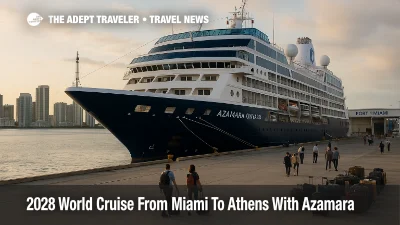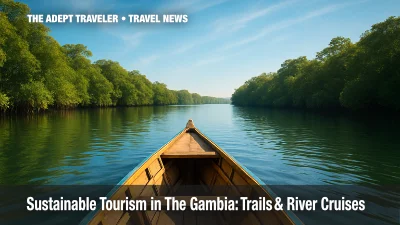Madagascar
When you choose to travel to Madagascar, you embark on an adventure that's unparalleled in its rich biodiversity, stunning landscapes, and vibrant cultures. As the world's fourth-largest island, Madagascar promises an exotic getaway where the natural spectacle is the star attraction. Nestled off the southeastern coast of Africa, this island nation is a treasure trove of endemic wildlife, making it a haven for nature enthusiasts and eco-travelers alike. Imagine wandering through lush rainforests alive with the chattering of lemurs, or snorkeling in the crystal-clear waters of Nosy Be, surrounded by vibrant coral reefs and multicolored marine life. Travel to Madagascar to experience the ethereal beauty of Avenue of the Baobabs, famously lined with ancient baobab trees that create an almost otherworldly landscape. For those with a penchant for adventure, trekking in the rugged terrains of Isalo National Park or exploring the intricate networks of the Tsingy de Bemaraha, a UNESCO World Heritage Site, offers thrilling experiences that are hard to replicate elsewhere. Let's not forget the fascinating culture in Madagascar; from the Malagasy people's warm hospitality to the bustling markets in Antananarivo filled with handmade crafts and local delicacies, every moment spent here enriches your travel experience uniquely. Traveling to Madagascar is not merely a visit but an immersive journey into nature, culture, and unparalleled beauty that promises memories to last a lifetime. If you have an unquenchable wanderlust for places that combine both extraordinary natural beauty and cultural richness, Madagascar should undoubtedly be at the top of your list.
The History of Madagascar
Madagascar, the world's fourth-largest island, beckons travelers with its rich tapestry of history, culture, and biodiversity. Steeped in ancient legacies and colonial influences, this fascinating destination offers a unique glimpse into a past that has shaped the vibrant present. When you travel to Madagascar, you embark on a journey through time, discovering the diverse narratives that have crafted this enigmatic island. From ancient human settlements to colonial intrigues, the history of Madagascar is a compelling saga of resilience and adaptation.
Travel to Madagascar and explore its early human history, which remains a subject of intrigue and wonder. Archaeological findings reveal that the island was one of the last major landmasses to be colonized by humans, possibly as late as 350 BCE. These early settlers, believed to have originated from the Austronesian region, navigated across the Indian Ocean, bringing with them a blend of cultures and traditions. By the advent of the Common Era, Bantu-speaking migrants from mainland Africa enriched the cultural mosaic, leading to the development of complex societal structures. This unique convergence of Asian and African influences is a keystone in understanding Madagascar's enduring cultural heritage.
Madagascar's historical landscape is further adorned with the legacies of European colonialism. The Portuguese were the first Europeans to make contact in the 16th century, but it was the French who eventually established dominion over the island in the 19th century. Travel to Madagascar and witness traces of this era in the elegant colonial architecture and historical forts scattered across the island. The Impressive Queen's Palace in Antananarivo stands as a monumental testament to the Merina monarchy’s resistance and eventual capitulation to French forces. This epoch carved a distinct identity for Madagascar, blending Malagasy traditions with European influences, creating a unique cultural fusion seen in the island's art, cuisine, and societal structure.
Travel to Madagascar also provides a window into the island's role in global maritime history. As a strategic location along the Indian Ocean trade routes, Madagascar was a bustling hub for traders and pirates alike. The infamous pirate utopia of Libertalia, though shrouded in myth, highlights the island's allure to seafarers seeking fortune and refuge. Exploring the coastal areas of Madagascar, you can uncover tales of swashbuckling adventures and maritime exploits that continue to captivate historians and tourists alike. With its myriad historical sites and intriguing narratives, traveling to Madagascar offers an unparalleled opportunity to immerse yourself in a rich tapestry of human history that is both unique and endlessly captivating.
The Culture of Madagascar
Madagascar, often referred to as the "Eighth Continent," is truly a destination like no other. A vast island nation situated off the southeastern coast of Africa, Madagascar is a melting pot of cultures, traditions, and natural wonders waiting to be explored. When you travel to Madagascar, you are not just visiting a place, but you are diving into a vibrant and diverse world filled with rich history and extraordinary traditions. One compelling reason to travel to Madagascar is its unique cultural tapestry, shaped by centuries of diverse influences.
One of the most fascinating aspects of traveling to Madagascar is experiencing the Malagasy people, whose warmth and hospitality are legendary. The island's population is a mosaic of ethnic groups, with 18 recognized tribes, each with its distinct customs and ways of life. The Merina and Betsileo people, known for their highland rice cultivation techniques, offer an insight into sustainable farming practices passed down through generations. Meanwhile, the coastal tribes, such as the Vezo and the Sakalava, are renowned for their seafaring skills and vibrant fishing communities. When you travel to Madagascar, engaging with these diverse communities and learning about their ways of life is truly enriching.
Traditional Music and Dance
One cannot travel to Madagascar without being captivated by its traditional music and dance, which are integral to the island's cultural identity. The rhythms of Malagasy music, often played on instruments like the valiha (a bamboo tube zither) and the marovany (a box zither), are both mesmerizing and uplifting. These musical traditions are often accompanied by lively dances that tell stories of historical events, daily life, and the natural world. Festivals such as the Famadihana, or "turning of the bones," are grand celebrations where families honor their ancestors through music, dance, and feasting, providing visitors with a deep and moving insight into Malagasy spirituality and communal life.
Artisanal Crafts and Markets
Madagascar is also a treasure trove for those interested in artisanal crafts. The island's marketplaces are vibrant hubs where one can find beautifully handmade items that reflect the island's diverse cultural heritage. From intricately woven textiles and wood carvings to exquisite jewelry and pottery, the artisanal skills of the Malagasy people are a testament to their creativity and resourcefulness. Shopping in these local markets not only supports the local economy but also allows travelers to take home a piece of Madagascar's rich cultural heritage.
Another alluring aspect of Madagascar is its cuisine, which is as diverse as its people. Influenced by African, Asian, and European culinary traditions, Malagasy food offers a flavorful journey for the palate. Staples such as rice, zebu (a type of cattle), and a variety of fresh seafood are artfully prepared with unique local spices and ingredients. Signature dishes like Romazava (a meat and leafy green stew) and Mofo Gasy (a type of Malagasy pancake) are must-tries for any traveler. Additionally, communal eating and the sharing of food play a significant role in Malagasy culture, providing a perfect opportunity for visitors to engage and connect with locals over a meal.
Traveling to Madagascar offers an unparalleled cultural experience that goes beyond just sightseeing. From the island's rich musical traditions and vibrant markets to its unique culinary delights and deep-rooted communal values, every aspect of Malagasy culture invites visitors to immerse themselves in an extraordinary journey. When you travel to Madagascar, you are not merely a spectator but become part of the living tapestry that makes this island one of the most culturally captivating destinations in the world.
The Food of Madagascar
The enchanting island of Madagascar offers much more than stunning landscapes and unique wildlife. For those who are passionate about culinary adventures, a travel to Madagascar presents an unparalleled gastronomic journey worth exploring. Imagine tantalizing your taste buds with a fusion of flavors that meld African, Asian, and European influences into a distinct and vibrant culinary tradition. Travel enthusiasts with a penchant for food will find themselves enamored by the rich and diverse culinary landscape that Madagascar has to offer.
A Flavorful Blend of Cultures
Madagascar’s history is a tapestry woven from a diverse array of cultures, each leaving an indelible mark on the island's cuisine. Travelers will discover a fusion of flavors that combine the aromatic spices of India, the fresh ingredients of Southeast Asia, and the hearty staples of African cuisine. Traditional Malagasy dishes such as "Romazava" (a meat stew with greens) and "Ravitoto" (ground cassava leaves) are must-try delicacies that beautifully showcase the island's culinary heritage. Visiting local markets and eateries allows travelers to immerse themselves in the daily life of Madagascar, sampling fresh produce and discovering lesser-known ingredients that are pivotal to Malagasy cooking.
Seafood Extravaganza
For seafood aficionados, travel to Madagascar promises a true paradise. The island’s extensive coastline and rich marine biodiversity result in a bounty of fresh seafood that is both abundant and delectable. Whether you are savoring chargrilled langoustine on a beachfront restaurant, enjoying a fragrant seafood curry infused with coconut milk, or relishing a simple but exquisite plate of grilled fish seasoned with local herbs, the seafood offerings are bound to impress. The waters surrounding Madagascar are teeming with fish, shrimp, crab, and other marine treasures, ensuring that each meal is a fresh and unforgettable experience.
Exotic Fruits and Spices
Madagascar is renowned for its exceptional vanilla, but the island also produces a wealth of other exotic spices and fruits that are integral to its cuisine. Visitors will be delighted to find markets brimming with vibrant and aromatic offerings such as cloves, cinnamon, and the fiery Malagasy peppers. The island's tropical climate is ideal for growing an array of mouth-watering fruits, including lychees, mangoes, and guava. As you travel across Madagascar, taking part in a spice tour or visiting a plantation can provide fascinating insights into the cultivation and importance of these ingredients in Malagasy cooking. Sipping on freshly made fruit juices and sampling desserts infused with local spices are experiences that make travel to Madagascar truly unique.
Beyond just dining, the culinary experience in Madagascar includes hands-on opportunities to learn and participate in the food culture. Many places offer cooking classes where travelers can learn to prepare traditional Malagasy dishes, providing a deeper connection to the island's rich gastronomic traditions. Engaging with friendly locals, understanding the stories behind the dishes, and sharing meals in a community setting are all part of what makes travel to Madagascar an unmatched culinary adventure. Whether you're an epicurean or simply someone who loves to explore new flavors, Madagascar offers an endlessly rich and flavorful experience that beckons travelers from around the world.
What to See and Do in Madagascar
Travel to Madagascar, an island nation located off the southeast coast of Africa, is an adventure brimming with diverse experiences. This unique destination promises adventures that can't be found anywhere else. Below are ten essential activities that every traveler in Madagascar should prioritize:
Explore the Avenue of the Baobabs, Morondava, Madagascar
No trip to Madagascar is complete without visiting the iconic Avenue of the Baobabs. This stunning dirt road, flanked by towering baobab trees, offers a surreal landscape that seems almost otherworldly at sunset. The trees are ancient, with some believed to be over 800 years old. The warm light of the setting sun creates striking contrasts and presents fantastic photo opportunities. Don't miss the small local markets nearby, where you can purchase handmade crafts and learn about the cultural significance of these majestic trees.
Visit the Tsingy de Bemaraha National Park
Tsingy de Bemaraha National Park is a UNESCO World Heritage site and is one of the most fascinating landscapes you will ever encounter. The "Tsingy" formations are sharp limestone pinnacles that have formed through millennia of erosion. Exploring this park involves navigating via suspension bridges, climbing sharp cliffs, and walking through labyrinthine paths. The flora and fauna here are unique, including several species of lemurs and rare birds. A visit here offers not just natural beauty but a test of your adventurous spirit.
Spot Lemurs at Andasibe-Mantadia National Park, Andasibe, Madagascar
Andasibe-Mantadia National Park is a must-visit for wildlife enthusiasts, especially those eager to see lemurs in their natural habitat. This park is home to the largest species of lemur, the Indri Indri, known for its loud, distinctive call. Guided tours offer insights into the park's biodiversity, and night walks reveal nocturnal species. Bird watchers will also find this park a paradise, with a range of indigenous bird species to observe. The mossy forests and cascading waterfalls add to the park's ethereal beauty.
Relax on Nosy Be Island
For those looking to unwind, Nosy Be Island offers pristine beaches, clear turquoise waters, and luxurious resorts. Located off Madagascar's northwest coast, Nosy Be is the perfect spot for snorkeling, diving, and exploring marine biodiversity. The island also features fragrant ylang-ylang plantations and interesting local markets. Be sure to visit the Lokobe Reserve to see more endemic wildlife, and don't miss a traditional Malagasy meal at one of the beachfront restaurants.
Trek through Isalo National Park, Isalo, Madagascar
Isalo National Park is famous for its rugged landscapes, deep canyons, and natural swimming pools. It's ideal for trekking and offers routes suitable for all levels of hikers. The park’s flora includes rare plants like the elephant's foot and the fire-resistant tapia tree. As you trek, you might spot lemurs or even the elusive ring-tailed mongoose. The Namaza circuit takes you through breathtaking viewpoints, mysterious caves, and refreshing natural pools, offering a complete adventure package.
Discover the Underwater World at Nosy Tanikely Marine Reserve
Just a short boat ride from Nosy Be, Nosy Tanikely Marine Reserve is a prime location for snorkelers and divers. The protected status of this reserve ensures that its coral reefs are teeming with life, including colorful fish, sea turtles, and various crustaceans. Guided snorkeling tours can take you to the best spots, while a climb up the island’s lighthouse offers panoramic views of the surrounding waters. The island itself is a protected area, providing a haven for several bird species and small mammals.
Visit the Royal Hill of Ambohimanga, Antananarivo, Madagascar
Located near Antananarivo, the Royal Hill of Ambohimanga is a historical and spiritual site of great importance to the Malagasy people. This UNESCO World Heritage site was once home to Madagascar’s royalty and is considered one of the country’s most significant cultural sites. The hill features ancient palaces, traditional villages, and sacred burial grounds. The panoramic view of the surrounding landscapes adds to the sense of history and majesty found here. Guided tours offer insights into the rituals and traditions of Madagascar's past.
Experience Antananarivo’s Bustling Markets
Antananarivo, the capital city of Madagascar, offers a vibrant market scene that’s a feast for the senses. The Analakely Market is a bustling hub where you can find anything from local handicrafts to fresh produce. The street food here is a must-try, offering traditional Malagasy dishes such as "romazava" and "masikita" (beef skewers). The Digue Market, another popular spot, specializes in handmade crafts, making it perfect for souvenir shopping. Exploring these markets provides a deep dive into the daily life and culture of the Malagasy people.
Explore the Fishing Villages of Ifaty
Ifaty, a coastal village near Toliara, offers a tranquil escape with its serene beaches and traditional lifestyle. The Vezo people, known as "the people of the sea," inhabit this area and continue age-old fishing practices. Exploring these villages gives you a glimpse into their unique culture and maritime skills. The nearby Reniala Forest Reserve is home to various endemic species and the iconic baobab trees. Ifaty is also known for excellent snorkeling and diving opportunities, with vibrant coral reefs just off the coast.
Bird Watching in Ankarafantsika National Park
Birdwatchers will find a paradise in Ankarafantsika National Park, which is home to over 120 bird species, including the critically endangered Madagascar Fish Eagle. The park’s diverse ecosystems range from dense forests to savannas, offering different habitats for various species. Walking trails and guided tours allow you to explore these ecosystems while spotting lemurs, chameleons, and even crocodiles along Ravelobe Lake. The park's unique plant life, like the baobab trees and medicinal plants, adds to its ecological richness.
Travel to Madagascar offers an unparalleled combination of unique landscapes, rich biodiversity, and vibrant culture. Incorporate these ten activities in your itinerary to ensure a fulfilling and unforgettable trip.
Why You Should Travel to Madagascar
Travelers from around the world are drawn to the diverse and captivating allure of Madagascar. This island nation in the Indian Ocean offers an unparalleled mix of natural beauty and unique wildlife that sets it apart from any other destination. When you travel to Madagascar, you'll encounter an incredible variety of landscapes, from lush rainforests and arid deserts to sparkling beaches and striking limestone formations. Such diversity not only enhances the visual appeal of the island but also provides various ecosystems that are home to an astonishing array of flora and fauna. Visitors can expect to see species that exist nowhere else on earth, making every exploration feel like a discovery of a new world.
One of the main reasons travelers are enchanted by Madagascar is its iconic wildlife, particularly its primates. The island is famous for its variety of lemurs, which range from the small and cute bamboo lemur to the large and eerie indri. These unique creatures are accompanied by a host of other endemic species such as the fossa, a cat-like predator, and an assortment of vibrant chameleons and exotic birds. The island’s national parks, such as Andasibe-Mantadia and Ranomafana, serve as sanctuaries preserving these incredible species. Visitors often embark on guided tours that provide educational insights, enriching their travel to Madagascar experience with a deeper understanding and appreciation of conservation efforts.
Beyond its wildlife, Madagascar offers travelers rich cultural experiences and historical landmarks. From the bustling markets of Antananarivo, the island's capital, to the ancient stone towns and ruins that dot the landscape, there is a wealth of history to uncover. Local communities are known for their warm hospitality, offering tourists a chance to engage in and learn about Malagasy traditions, music, and cuisine. Festivals, traditional dances, and crafts provide colorful and immersive experiences that stay with travelers long after they have returned home. The island’s relatively untouched status means that your travel to Madagascar can feel like a step back in time, offering an authentic glimpse into a way of life that has remained largely unchanged for centuries.
Why You Must Travel to Madagascar
Traveling to Madagascar is an opportunity unlike any other, combining adventure, natural wonders, and cultural richness in one destination. The island offers something for every kind of traveler, whether you're a nature enthusiast eager to spot rare species, an adventurer looking to trek through diverse terrains, or a culture lover wanting to delve into fascinating traditions and history. The unique experiences awaiting you in Madagascar cannot be replicated anywhere else on the planet. So if you’re searching for a travel destination that promises both excitement and enlightenment, Madagascar is calling. Make sure to embark on this unforgettable journey and immerse yourself in the unparalleled beauty and wonder that Madagascar has to offer.
Tips & Tricks for Traveling in Madagascar
A trip to Madagascar, the island nation off the southeastern coast of Africa, offers an unparalleled travel experience filled with unique wildlife, stunning landscapes, and rich cultural heritage. While traveling to Madagascar can be incredibly rewarding, there are certain tips and tricks that can make your journey even more enjoyable and stress-free.
Plan Your Travel to Madagascar During the Dry Season
The best time to travel to Madagascar is during the dry season, which runs from April to October. During these months, you can expect pleasant weather and better road conditions, making it easier to explore the island's diverse attractions. Additionally, the dry season offers excellent opportunities for wildlife sightings as many species are more active and visible.
Use Local Guides for a Better Experience
Hiring local guides can significantly enhance your travel experience in Madagascar. These guides bring invaluable knowledge about the local fauna, flora, and customs. They can also help navigate some of the more challenging terrain and communicate effectively with locals, enriching your travel experience with insights you might miss otherwise.
Embrace the Local Cuisine
Madagascar offers a delicious blend of African, Asian, and European flavors. When you travel to Madagascar, make sure to indulge in local dishes such as Romazava (a meat and greens stew), Ravitoto (crushed cassava leaves with pork), and freshly caught seafood. Exploring local markets can also give you a taste of Malagasy snacks and exotic fruits.
Travel Insurance is a Must
Ensure you have comprehensive travel insurance before you depart. Madagascar's healthcare infrastructure is still developing, and medical facilities can be limited in rural areas. A good travel insurance policy will cover medical emergencies, trip cancellations, and other unforeseen issues that could arise during your travel to Madagascar.
Learn Basic Malagasy Phrases
While French is widely spoken, especially in urban areas, learning some basic Malagasy phrases can go a long way in enhancing your travel to Madagascar. Simple greetings and expressions will make interactions more meaningful and can even help you in tricky situations.
Respect Local Customs and Traditions
Madagascar is rich in traditions and customs that vary regionally. Respecting these customs is crucial for a positive travel experience. Always ask for permission before photographing people, avoid public displays of affection, and be mindful of local etiquette. Understanding and respecting these cultural nuances will greatly enrich your travel to Madagascar.
Pack Appropriately
When you travel to Madagascar, it’s essential to pack wisely. Lightweight, breathable clothing is ideal for the hot, humid climate. However, don’t forget warmer layers for the cooler highland regions. Sturdy walking shoes are a must for exploring national parks, and don’t forget insect repellent and sunscreen.
Use Local Transportation Wisely
The island's transportation infrastructure can be challenging but is more than manageable with some planning. "Taxi-brousse" (bush taxis) are the most common form of public transport and can reach remote areas, though they can be slow and crowded. Alternatively, renting a 4x4 vehicle can offer more comfort and flexibility for your travel in Madagascar.
Stay Connected
While Madagascar is relatively remote, staying connected is easier than you might expect. Most urban centers and tourist hotspots offer Wi-Fi. Consider buying a local SIM card for more reliable connectivity during your travels. This can be particularly useful for navigation and staying in contact with guides and accommodations.
Contribute to Sustainable Tourism
Sustainable tourism is increasingly important in Madagascar. When you travel to this captivating island, try to support eco-friendly accommodations, responsible tour operators, and local businesses. This not only helps protect the environment but also supports the local economy and promotes cultural preservation.
From mindful planning and packing to embracing local customs and cuisine, these tips and tricks can significantly enhance your travel to Madagascar. By paying attention to these details, your journey to Madagascar will be more comfortable, enriching, and memorable.
Other Places You Might Like
Nosy Be, Madagascar - If you love the exotic allure of Madagascar, you will be enchanted by Nosy Be. Known as "The Perfume Island," Nosy Be offers fragrant ylang-ylang plantations, turquoise waters, and vibrant coral reefs that are perfect for diving and snorkeling. The island's rich biodiversity includes the unique lemurs and an array of bird species, similar to what makes Madagascar so captivating. The relaxed island vibe and stunning natural beauty will remind travelers of the tranquility found in Madagascar.
Phuket, Thailand - Travelers drawn to Madagascar's natural beauty and biodiversity will find a paradise in Phuket. While different in some respects, Phuket offers lush landscapes, crystal-clear beaches, and an option for eco-tours in its dense mangrove forests, reminiscent of Madagascar's rainforests. Whether you're exploring the vibrant marine life through scuba diving or indulging in the local cuisine, Phuket provides a rich and diverse travel experience.
Galápagos Islands, Ecuador - Much like Madagascar, the Galápagos Islands are famed for their unique ecosystem and endemic species. Travelers intrigued by Madagascar's ring-tailed lemurs and baobab trees will be equally fascinated by the Galápagos' giant tortoises, marine iguanas, and blue-footed boobies. Coupled with opportunities for snorkeling and hiking through volcanic landscapes, the Galápagos offer an otherworldly adventure for nature enthusiasts.
Palawan, Philippines - Palawan is a haven for those who adore Madagascar's breathtaking scenery. Known for its stunning limestone cliffs and crystal-clear waters, Palawan provides an abundance of activities such as diving in Tubbataha Reefs Natural Park, exploring the Puerto Princesa Subterranean River, and lounging on immaculate beaches. This archipelago is a visual feast that will captivate any lover of natural beauty.
Unique Ecosystems
Amazon Rainforest, Brazil - Travelers fascinated by Madagascar's rich biodiversity should explore the Amazon Rainforest. As one of the most biodiverse regions on the planet, the Amazon offers an immersive experience with a stunning variety of flora and fauna. Guided tours can take you deep into the jungle, where you'll encounter exotic wildlife, indigenous tribes, and a dense canopy that creates an enigmatic atmosphere similar to Madagascar's own rainforest treasures.
Borneo, Malaysia - Those enchanted by the unique wildlife of Madagascar will find a world of wonder in Borneo. This island offers travelers a chance to observe orangutans, pygmy elephants, and other rare species in their natural habitats. Borneo's various national parks and reserves, such as the Kinabatangan River and Danum Valley, provide extensive opportunities for eco-tourism, much like the wildlife-centric experiences available in Madagascar.
Cultural Heritage
Chiang Mai, Thailand - Like Madagascar, which boasts rich cultural traditions and history, Chiang Mai offers a deep dive into local culture. This city in northern Thailand is teeming with ancient temples, vibrant markets, and traditional crafts. The lush landscape combined with cultural immersion makes Chiang Mai an enriching experience for anyone captivated by Madagascar's unique cultural tapestry.
Luang Prabang, Laos - For travelers who appreciate Madagascar’s blend of culture and nature, Luang Prabang is another gem. This UNESCO World Heritage city is set amidst a lush tropical landscape and is known for its well-preserved architecture, traditional Buddhist temples, and vibrant morning markets. The serene environment and rich cultural experiences offer a tranquil yet enriching visit that parallels the allure of Madagascar.
Islands and Beaches
Mauritius, Mauritius - Mauritius, much like Madagascar, is a paradise for beach lovers. Known for its pristine beaches, this island also offers a touch of luxury with world-class resorts and unique natural attractions like the Seven Coloured Earths. The diverse marine life and incredible coral reefs offer excellent diving opportunities, making it a compelling destination for those who have enjoyed the coastal wonders of Madagascar.
Seychelles, Seychelles - The Seychelles archipelago is another splendid destination for travelers who love Madagascar. Its 115 islands boast some of the world's best beaches, crystal-clear waters, and abundant marine life, offering an idyllic setting for snorkeling, diving, and relaxation. Seychelles' rich biodiversity and stunning natural scenery provide an experience akin to Madagascar's most picturesque locales.
Antananarivo, Madagascar

Morondava, Madagascar

Nosy Be, Madagascar

Madagascar Advisory Level 2, Hotspots Still Flagged

Portugal Long Haul Flights Get TAP Premium Economy

Asia Pacific Design Hotel Openings Through 2025

2028 World Cruise From Miami To Athens With Azamara

UAE Africa Tourism Plan To Fund $6 Billion Projects

Regional Airline Cancellations Hit African Hubs

Air France pauses Paris-Antananarivo through October 13

Madagascar travel advisory, protests disrupt flights

Flight delays and airport impacts: October 8, 2025

Mozambique Lowers Advisory, but Northern Hotspots Persist

Intrepid Travel Mystery Tour Promises 14-Day African Adventure

How The Gambia Is Turning Trails and River Cruises into a Model of Sustainable Tourism

